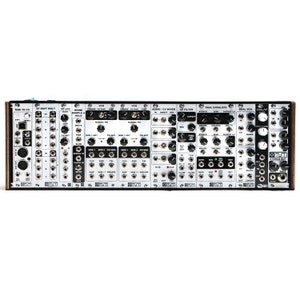For those already invested into modular synthesis, VCA's need no introductions. You can never have too many of them, and they offer essential functionality for the end of your modular chain.
The Callosum Dual VCA is based on the Mutable Instruments Veils module; one among so many amazing products created by Mutable over the years. Since I have limited space to work with, I sliced Veils in half from a Quad VCA to a Dual VCA and Callosum is the result. If you want to expand, there are connectors on each module that allow you to daisy-chain several Callosum VCA's together.
You can use Callosum for the simple purpose of amplifying/attenuating the sound coming in. Essentially, a volume control with adjustable gain. You can also use it as a 2 input mixer. Each VCA can have a separate input and output, but if nothing is plugged into the first VCA output, the module will mix and normalize both VCA inputs into the second VCA output.
There is also a CV input jack on each VCA into which you can insert an external voltage. This allows you to gate the input (sync the audio signal with a tempo beat for example) or use it as a voltage controlled gain input.
The response curve can be faded between Linear and Exponential using a rotary control on each VCA.
The rotary control at the top of each VCA has 2 functions depending on how the module is patched. If there is a cable plugged into the CV input, it will control the gain level of the CV signal. If nothing is connected to the CV input, it will serve as a manual gain control for the VCA.
****
The idea for Synax and MagPower evolved over the past several years, while dealing with the aftermath of losing my job of 15 years due to Covid. This project kept me going, day in and day out, because I believed in the idea and fell in love with the process of research and design that goes into every Synax module. It gave me something to focus on when my mind was filled to the brim with worries about the future. I worked all the time developing the MagPower system and creating Synax modules, but wasn't getting any money from it. I'm hoping that others will find as much interest in the system as I have throughout the development process. The current Synax modules available are only the beginning. I have numerous modules in development and several modules close to the finish. I try to do as much homework and testing as possible to be sure that you're getting a quality product in the end.
MagPower is based newest around a magnetic connection between three pogo pins on the power panel and 3 copper tracks on the back of each Synax module. Power into the panel comes from a standard 10-pin Eurorack connector. From there it gets filtered and sent through a twin-IC hot-swap circuit. This allows Synax modules to be swapped in and out on-the-fly during a performance while protecting both the MagPower panel and the rest of your system from being affected due to over/under voltage or current.
The Synax module itself is comprised of 2 boards secured to each other with 6mm standoffs. One side of the main board provides the user controls, and the reverse contains all of the circuitry to make it work. To this is connected another board of the same size that provides power to the module from the magnetic connection on the Eurorack power panel. The module power board is attached to the main board with 4 standoffs and several pogo pins to provide power without being permanently wired to the module. This allows you to quickly and easily swap out the main or power board if required, or access the programming pins on modules using a microcontroller. A screwdriver is the only tool needed to take everything apart.
*Note: Synax modules require the MagPower Eurorack power panel to use, which is sold separately.
Product code: New Synax! Dual VCA in a fun-sized newest format powered by the Synax MagPower system.
/i/079471/products/2024-09-18T10:21:12.886Z-DnD.jpg)



